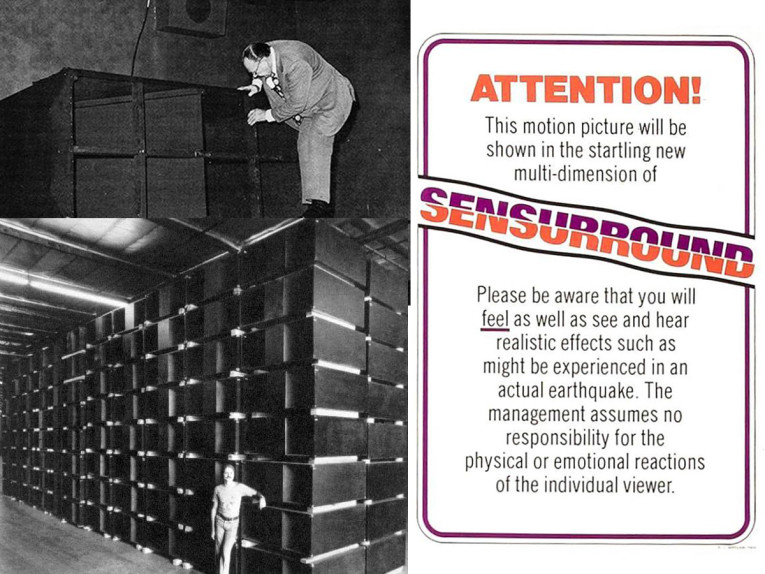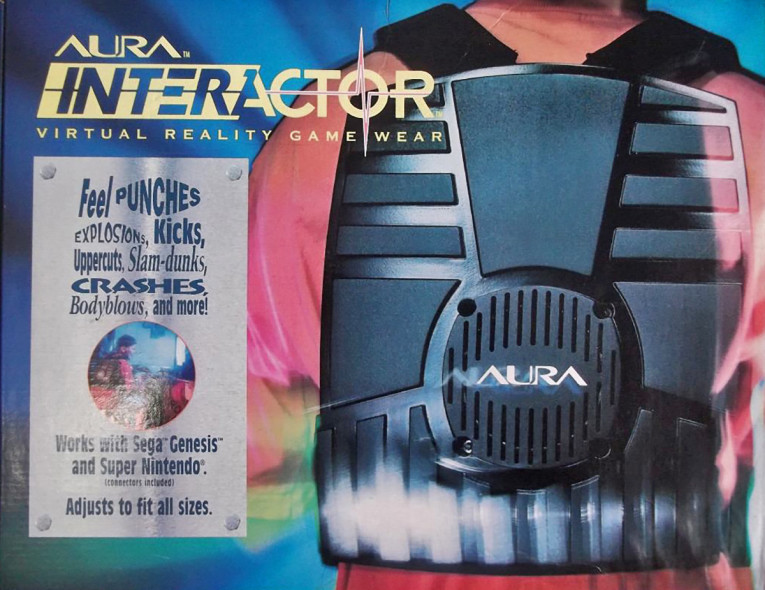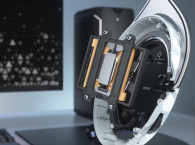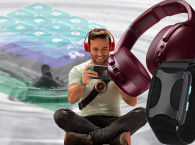
Phonograph records did not quite capture the deepest bass, as this was too much for most phonograph cartridges to track. However, modern CDs, DVDs, Blu-ray Discs, and even the MP3s and other compressed audio formats can reproduce these low frequencies with ease. Still, the challenge remains in the playback. Getting your soundbar, home theater in a box (HTiB), or even a decent surround-sound system to realistically reproduce the feel of concert bass is an exercise in optimism.
We hear airborne music through our ears and we perceive structural bass energy through tactile perception. Reproduction of this structural component of live sound can be achieved through the use of a tactile transducer or “bass shaker.”
Bass shakers are physically coupled to various surfaces and pass low-frequency vibrations into them so that they can be felt by the listener. Tactile transducers may augment a subwoofer, but they cannot be substituted for a subwoofer. Tactile transducers are used in home theaters, commercial movie theaters, arcade games for special effects, amusement park rides, and aerobic studios, and so forth. Some innovative applications have also been developed for the hearing impaired, bypassing the hearing system in a manner similar to a cochlear implant.
As for actual installation, a bass shaker is firmly attached to a surface (e.g., a seat, a couch, or a floor). The bass shaker houses a small weight (typically a moving magnetic structure) that is driven by a stationary voice coil. The voice coil uses a conventional power amplifier to reproduce a low-frequency audio signal (e.g., the effects from a Dolby LFE boom channel). The voice coil exerts force on the weight and the bass shaker’s body, with the latter forces transmitted into the mounting surface.
When it comes to seating design for bass shakers, it is important to fool the senses. If the bass shaker only drives a chair, your senses won’t be fooled, particularly if it is apparent that only the chair is vibrating. But if the chair, ottoman, and floor have shakers, then the entire room will appear to vibrate. There is also a preferred balance of vibration distribution between the back, waist, hips, and buttocks.

Program Processing for Tactile Reproduction
Poor bass content factored into the slow acceptance of these devices. We already discussed the limitations of vinyl LPs and cassettes. The bottom end tended to be a bit irregular due to tape speed, tape-head geometry considerations, and related compromises for good tape-to-head contact. Other magnetic tape formats (e.g., the open reel) provided acceptable bass reproduction for tactile reproduction but were not commonly found in most consumer hi-fi systems. Also, very few record labels produced any reel-to-reel program material.
An early kluge was the use of a subharmonic synthesizer (e.g., the dbx 100 Boom Box). This device synthesized extreme bass from the existing bass signal (see Photo 1). Another issue with using stereo two-channel program material was that any dialog with bass content (e.g., a deep male voice) would be included with and detract from the tactile effect.
CDs and Dolby surround, which has a dedicated “boom channel,” changed all this. The Dolby effects channel separated the dialog from the signal sent to the subwoofers (and tactile devices). Response optimization benefits from the most realistic tactile contribution and adds to the overall experience. In reading comparative bass shaker reviews and attempting to measure output, we want to offer some caveats. As with most electroacoustic transducers, there is a gain vs bandwidth tradeoff with just about everything. It is easy to design an efficient bass shaker with huge output. Think of a bass shaker as having a Q, so a high-Q design would have a lot of output over a very narrow band of bass frequencies — similar to a one-note subwoofer. Alternatively, we can design for a wider Q and more linear response over the operating range, but at the expense of efficiency. Products that are reviewed by unsophisticated hobbyists and found to be super-efficient may just be a “one-note” design that wants to vibrate at their favorite but narrow frequency range.
Some History
An entire generation of movie goers first encountered tactile effects when Earthquake debuted in 1974 (see Photo 2). In this disaster film, a catastrophic earthquake destroys most of Los Angeles, CA. Speaker company Cerwin-Vega, in conjunction with Universal Studios, developed deep bass horns driven by high-power amplifiers and used gated noise generators as the signal source to shake the theaters at the appropriate moments. The experience rattled moviegoers and was a huge commercial success.
Clearly, the entertainment consumer had an appetite for Earthquake’s tactile experience, and several films featuring “Sensurround” quickly followed. Just two years later in 1976, Nozomu Matsumoto founded Bodysonic. Matsumoto is best known as the founder of Pioneer Electronics in Japan. Bodysonic was the first “bass shaker,” which Matsumoto supposedly developed in his hobby shop.
Some time between 1982 and 1984 author Mike Klasco experienced tactile transducers firsthand. At the time, he represented Bodysonic in the US for commercial sound applications (e.g., amusement and theme parks, discothèque floors and other non-residential applications). One flagship project was for the Disney Epcot Center’s GE Pavilion, where the ride seats had Bodysonic installed. Bodysonic also had some success with automobile sound systems. It was installed in the 1984 Nissan 300ZX anniversary edition. Toyota also worked with Fujitsu-10 on a couple of sports models using Bodysonic technology.

In the mid to late 1980s, Klasco worked with Sammi Sound on its Volcano shakers, which were also sold as the Phillips Resonators. They were popular with autosound aftermarket installers, which used them to supplement the subwoofers. Around 1992, Klasco consulted for Aura Systems, which at the time was a high-tech firm focused on the US government’s “Star Wars” projects. Aura Systems designed and built powerful push-pull actuators with unique magnetic topology for some very esoteric military applications. As the firm wanted to diversify to consumer products, Klasco suggested that a tactile bass device would be a great fit for its core competence in-linear actuators.
A speaker group was formed with a very talented team. Drew Kallen and his associates filed for bass shaker patents in 1993 and Aura Systems entered the shaker business, eventually building variants for other brands including Alpine and RBH (see Photo 3). Another clever product from Aura Systems was the Interactor Vest, which users strapped on similar to a backpack. Designed for video games, it provided a huge impact. But, the product was too ahead of its time for the gaming products of the mid 1990s. Today, the Interactor would be ideal for connection to the bass effects channel (see Photo 4).
In 2001, Panasonic introduced tactile headphones. Marketed as “A Subwoofer for Your Head,” the RP-HS900 Brain Shaker Extreme incorporated a shaker in the neckband (see Photo 5). Fast forward to 2014 and Vivitouch introduced a new generation of 4-D Sound Haptic headphones to market.


Current Bass Shakers
In the current market there are a number of bass shaker products. Among them are a few of the more popular devices from ButtKicker, Clark Synthesis, and Earthquake. ButtKicker —ButtKicker’s tactile products are used in movie theaters, simulation rides, dance floors, 4-D theaters, planetariums, science centers, and amusement park attractions. The patented technology is promoted for home theaters as well as for unique applications at sporting events to broadcast along with the sound and video.
For sports-viewing applications, specially designed wireless sensors can be placed on the players. The impact they feel can become part of the broadcast, enabling fans at home to feel like they are part of the game. ButtKicker LIVE! brings “enabled sports” to the event (e.g., stadium, race track, or arena) as well as the home. By installing ButtKicker units in the seating (e.g., luxury boxes or a sponsor’s “best seats in the house”) fans can feel and become part of the action as it happens.
Clark Synthesis Transducers — Originally developed for military and commercial training applications, these tactile transducers can be used full range or for bass. Full-range applications include use with hot tubs and wall structures (for invisible speakers) and similar applications. The waterproof version can be used on pool walls.
Crowson Tech TES 100 — The Shadow-8 Dual Motion Actuator is designed to bring tactile effect to all types of chairs and couches. The Shadow-8 actuators can be installed by a person with no mechanical skill in less than 15 min. No modifications to furniture or flooring are required. The system easily interfaces with standard audio equipment using conventional audio signals.
Earthquake of San Francisco — Earthquake’s products range from high performance to over the top. Specifically, Earthquake’s Quake 10.0 is an ideal transition to next month’s topic of motion simulators, which is one step beyond tactile shakers. The Quake 10.0 is sensitive, articulate, and renders even the most complex low-frequency material in every detail. It is so powerful it can even replace some of the traditional hydraulic platforms in theme parks (see Photo 6).

Beyond Tactile — Motion Simulation
Shakers go beyond subwoofers to provide the tactile sensation of structural vibration, but they cannot simulate the gravitational forces of vehicle or aircraft acceleration. The motion cues necessary to trick the mind into thinking it is immersed in the simulated environment and experiencing kinematic changes in position, velocity, and acceleration require additional degrees of drive forces. This requires a motion simulator or motion platform to create the effect of being in a moving vehicle or roller coaster. aX
This article was originally published in audioxpress.com, April 2014.
Click to read Part 2 of this article.





